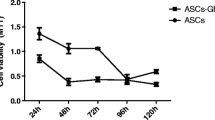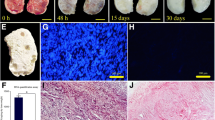Abstract
Purpose
To investigate if human ovarian grafting with pure virgin human recombinant collagen type-1 from bioengineered plant lines (CollPlant™) or small intestine submucosa (SIS) yields better implantation results for human ovarian tissue and which method benefits more when combined with the host melatonin treatment and graft incubation with biological glue + vitamin E + vascular endothelial growth factor-A.
Methods
Human ovarian tissue wrapped in CollPlant or SIS was transplanted into immunodeficient mice with/without host/graft treatment. The tissue was assessed by follicle counts (including atretic), for apoptosis evaluation by terminal deoxynucleotidyl transferase assay and for immunohistochemical evaluation of neovascularization by platelet endothelial cell adhesion molecule (PECAM) expression, and for identification of proliferating granulosa cells by Ki67 expression.
Results
Human ovarian tissue transplanted with CollPlant or SIS fused with the surrounding tissue and promoted neovascularization. In general, implantation with CollPlant even without additives promoted better results than with SIS: significantly higher number of recovered follicles, significantly fewer atretic follicles, and significantly more granulosa cell proliferation. Moreover, results with CollPlant alone seemed to be at least as good as those after host and graft treatments.
Conclusions
CollPlant is a biomaterial without any potential risks, and grafting ovarian tissue with CollPlant is easy and the procedure may be easily modified, with limited or no foreseeable risks, for auto-transplantation in cancer survivors. Further studies are needed using other novel methods capable of enhancing neovascularization and reducing apoptosis and follicle atresia.







Similar content being viewed by others
References
Feigin E, Freud E, Fisch B, Orvieto R, Kravarusic D, Avrahami G, et al. Fertility preservation in female adolescents with malignancies. In: Cancer in female adolescents. Hauppauge, New York: Nova Science Publishers Inc; 2008. p. 103–38.
Fisch B, Abir R. Female fertility preservation: past, present and future. Reproduction. 2018;156:F11–27. https://doi.org/10.1530/REP-17-0483.
Gougeon A. Regulations of ovarian follicular development in primates: facts and hypotheses. Endocr Rev. 1996;17:121–55. https://doi.org/10.1210/edrv-17-2-121.
Donnez J, Dolmans MM. Fertility preservation in women. N Engl J Med. 2017;377:1657–65. https://doi.org/10.1056/NEJMc1715731.
Tilly JL. Apoptosis and ovarian function. Rev Reprod. 1996;1:162–72.
Abir R, Fisch B, Jessel S, Felz C, Ben-Haroush A, Orvieto R. Improving posttransplantation survival of human ovarian tissue by treating the host and graft. Fertil Steril. 2011;95:1205–10. https://doi.org/10.1016/j.fertnstert.2010.07.1082.
Abir R, Fisch B, Fisher N, Samara N, Lerer-Serfaty G, Magen R, et al. Attempts to improve human ovarian transplantation outcomes of needle-immersed vitrification and slow-freezing by host and graft treatments. J Assist Reprod Genet. 2017;34:633–44. https://doi.org/10.1007/s10815-017-0884-8.
Friedman O, Orvieto R, Fisch B, Felz C, Freud E, Ben-Haroush A, et al. Possible improvements in human ovarian grafting by various host and graft treatments. Hum Reprod. 2012;27:474–82. https://doi.org/10.1093/humrep/der385.
Oktay K, Bedoschi G, Pacheco F, Turan V, Emirdar V. First pregnancies, live birth, and in vitro fertilization outcomes after transplantation of frozen-banked ovarian tissue with a human extracellular matrix scaffold using robot-assisted minimally invasive surgery. Am J Obstet Gynecol. 2016;214(1):94.e1–9. https://doi.org/10.1016/j.ajog.2015.10.001.
Mineur P, Colige AC, Deroanne CF, Dubail J, Kesteloot F, Habraken Y, et al. Newly identified biologically active and proteolysis-resistant VEGF-A isoform VEGF111 is induced by genotoxic agents. J Cell Biol. 2007;179:1261–73. https://doi.org/10.1083/jcb.200703052.
Labied S, Delforge Y, Munaut C, Blacher S, Colige A, Delcombel R, et al. Isoform 111 of vascular endothelial growth factor (VEGF111) improves angiogenesis of ovarian tissue xenotransplantation. Transplantation. 2013;95:426–33. https://doi.org/10.1097/TP.0b013e318279965c.
Stein H, Wilensky M, Tsafrir Y, Rosenthal M, Amir R, Avraham T, et al. Production of bioactive, post-translationally modified, heterotrimeric, human recombinant type-I collagen in transgenic tobacco. Biomacromolecules. 2009;10:2640–5. https://doi.org/10.1021/bm900571b.
McPherson TB, Liang H, Record RD, Badylak SF. Galalpha (1,3) Gal epitope in porcine small intestinal submucosa. Tissue Eng. 2000;6:233–9. https://doi.org/10.1089/10763270050044416.
Voytik-Harbin S, Brightman AO, Kraine MR, Waisner B, Badylak SF. Identification of extractable growth factors from small intestinal submucosa. J Cell Biochem. 1997;67l:478–91. https://doi.org/10.1002/(SICI)1097-4644(19971215)67:4%3C478::AID-JCB6%3E3.0.CO;2-P.
Cobb MA, Badylak SF, Janas W, Boop FA. Histology after dural grafting with small intestinal submucosa. Surg Neurol. 1996;46:389–93. https://doi.org/10.1016/S0090-3019(96)00202-9.
Hodde J, Badylak SF, Shelbourne KD. The effect of range of motion on remodeling of small intestinal submucosa (SIS) when used as an Achilles tendon repair material in the rabbit. Tissue Eng. 1997;3:27–37. https://doi.org/10.1089/ten.1997.3.27.
Allman AJ, McPherson TB, Badylak SF, Merrill LC, Kallakur B, Sheehan C, et al. Xenogeneic extracellular matrix grafts elicit a TH2-restricted immune response. Transplantation. 2001;71:1631–40.
Younis AJ, Lerer-Serfaty G, Stav D, Sabbah B, Shochat T, Kessler-Icekson G, et al. Extracellular-like matrices and leukemia inhibitory factor for in vitro culture of human primordial follicles. Reprod Fertil Dev. 2017;29:1982–94. https://doi.org/10.1071/RD16233.
Celik O, Esrefoglu M, Hascali S, Gul M, Tagluk ME, Elter K, et al. Use of porcine small intestinal submucosa to reconstruct an ovarian defect. Int J Gynecol Obstet. 2009;106:218–22. https://doi.org/10.1016/j.ijgo.2009.03.058.
Abir R, Ben-Haroush A, Felz C, Okon E, Raanani H, Orvieto R, et al. Selection of patients before and after anticancer treatment for ovarian cryopreservation. Hum Reprod. 2008;23:869–77. https://doi.org/10.1093/humrep/dem41.
Rahimi G, Isachenko V, Kreienber R, Sauer H, Todorov P, Tawadros S, et al. Re-vascularisation in human ovarian tissue after conventional freezing or vitrification and xenotransplantation. Eur J Obstet Gynecol Reprod Biol. 2010;149:63–7. https://doi.org/10.1016/j.ejogrb.2009.11.015.
Lerer-Serfaty G, Samara N, Fisch B, Shachar M, Kossover O, Seliktar D, et al. Attempted application of bioengineered/biosynthetic supporting matrices with phosphatidylinositol-trisphosphate-enhancing substances to organ culture of human primordial follicles. J Assist Reprod Genet. 2013;30:1279–88. https://doi.org/10.1007/s10815-013-0052-8.
Lande Y, Fisch B, Tsur A, Farhi J, Prag-Rosenberg R, Ben-Haroush, et al. Short term exposure of human ovarian follicles to cyclophosphamide metabolites seems to promote follicular activation in vitro. Reprod BioMed Online. 2017;34:104–14. https://doi.org/10.1016/j.rbmo.2016.10.005.
Hewitt SM, Baskin DG, Frevert CW, Stahl WL, Rosa-Molinar E. Controls for immunohistochemistry: the Histochemical Society’s standards of practice for validation of immunohistochemical assays. J Histochem Cytochem. 2014;62:693–7. https://doi.org/10.1369/0022155414545224.
Schmidt KLT, Byskov AG, Nyobe Andersen A, Muller J, Andersen CY. Density and distribution of primordial follicles in single pieces of cortex from 21 patients and in individual pieces of cortex from three entire human ovaries. Hum Reprod. 2003;18:1158–64. https://doi.org/10.1093/humrep/deg246.
Anderson RA, McLaughlin M, Wallace WHB, Albertini DF, Telfer EE. The immature human ovary shows loss of abnormal follicles and increasing follicle developmental competence through childhood and adolescence. Hum Reprod. 2014;29:97–106. https://doi.org/10.1093/humrep/det388.
Van Eyck AS, Bouzin C, Feron O, Rome L, Van Langendonckt A, Donnez J, et al. Both host and graft vessels contribute to revascularization of xenografted human ovarian tissue in a murine model. Fertil Steril. 2010;93:1676–85. https://doi.org/10.1016/j.fertnstert.2009.04.048.
Tang J, Hua Y, Su J, Zhang P, Zhu X, Wu L, et al. Expression of VEGF and neural repair after Alprostadil treatment in a rat model of sciatic nerve crush injury. Neurol India. 2009;57:387–94. https://doi.org/10.4103/0028-3886.55583.
Abir R, Orvieto R, Raanani H, Feldberg D, Nitke S, Fisch B. Parameters affecting successful transplantation of frozen-thawed human fetal ovaries into immunodeficient mice. Fertil Steril. 2003;80:421–8. https://doi.org/10.1016/S0015-0282(03)00658-7.
Demeestere I, Simon P, Buxant F, Robin V, Aguilar Fernandez S, Centner J, et al. Ovarian function and spontaneous pregnancy after combined heterotopic and orthotopic cryopreserved ovarian tissue transplantation in a patient previously treated with bone marrow transplantation: case report. Hum Reprod. 2006;21l:2010–4. https://doi.org/10.1093/humrep/del092.
Demeestere I, Simon P, Dedeken L, Moffa F, Tsepelidis S, Brachet C, et al. Live birth after autograft of ovarian tissue cryopreserved during childhood. Hum Reprod. 2015;3:2107–9. https://doi.org/10.1093/humrep/dev128.
Israeli T, Nevo N, Harmelin A, Neeman M, Tsafriri A. Reducing ischemic damage in rodent ovarian xenografts transplanted into granulation tissue. Hum Reprod. 2006;21:1368–79. https://doi.org/10.1093/humrep/del010.
Callejo J, Salvador C, Gonzalez-Nunez S, Almeida L, Rodriguez L, Marques L, et al. Live birth in a woman without ovaries after autograft of frozen-thawed ovarian tissue combined with growth factors. J Ovarian Res. 2013;6:33. https://doi.org/10.1186/1757-2215-6-33.
Mahmoodi M, Soleimani Mehranjani M, Shariatzadeh SM, Eimani H, Shahverdi A. Effects of erythropoietin on ischemia, follicular survival, and ovarian function in ovarian grafts. Reproduction. 2014;147:733–41. https://doi.org/10.1530/REP-13-0379.
Cohen Y, Dafni H, Avni R, Fellus L, Bochner F, Rotkopf R, et al. Genetic and pharmacological modulation of Akt1 for improving ovarian graft revascularization in a mouse model. Biol Reprod. 2016;94(14):1–11. https://doi.org/10.1095/biolreprod.115.131987.
Kang BJ, Wang Y, Zhang L, **ao Z, Li SW. bFGF and VEGF improve the quality of vitrified-thawed human ovarian tissues after xenotransplantation to SCID mice. J Assist Reprod Genet. 2016;33:281–9. https://doi.org/10.1007/s10815-015-0628-6.
Lee J, Lee JR, Youm HW, Suh CS, Kim SH. Effect of preoperative simvastatin treatment on transplantation of cryopreserved-warmed mouse ovarian tissue quality. Theriogenology. 2015;83:285–93. https://doi.org/10.1016/j.theriogenology.2014.09.027.
Lee J, Kim EJ, Kong HS, Youm HW, Lee JR, Suh CS, et al. A combination of simvastatin and methylprednisolone improves the quality of vitrified-warmed ovarian tissue after auto-transplantation. Hum Reprod. 2015;30:2627–38. https://doi.org/10.1093/humrep/dev222.
Morita Y, Perez GI, Paris F, Miranda SR, Ehleiter D. Oocyte apoptosis is suppressed by disruption of the acid sphingomyelinase gene or by sphingosine-1-phosphate therapy. Nat Med. 2000;6:1109–14. https://doi.org/10.1038/80442.
Soleimani R, Heytens E, Oktay K. Enhancement of neoangiogenesis and follicle survival by sphingosine-1-phosphate in human ovarian tissue xenotransplants. PLoS One. 2000;6:e19475. https://doi.org/10.1371/journal.pone.0019475.
Wu D, Lei Y, Tong Y, Tang F, Qian Y, Zhou Y. Angiogenesis of the frozen-thawed human fetal ovarian tissue at the early stage after xenotransplantation and the positive effect of Salviae miltiorrhizae. Anat Rec (Hoboken). 2010;293:2154–62. https://doi.org/10.1002/ar.21228.
Acknowledgments
We are grateful to Ms. Gloria Ganzach from the Editorial Board of Rabin Medical Center for the English editing and to Ms. Carmela Felz for the histological sections.
Funding
The study was partially funded by a research grant from the Israel Ministry of Health (for R.A. and B.F. no 3-6098-00000).
Author information
Authors and Affiliations
Contributions
R. Abir designed the study and collected the data, assisted in IMH studies and viewed the sections, conducted most of the statistical analysis, and wrote most of the manuscript. D. Stav conducted the CollPlant part of the study, wrote parts of the manuscript, and edited all the figures. Y. Taib conducted the SIS part of the study and wrote parts of the manuscript. R. Gabbay-Benziv conducted the SIS transplantations, assisted in the various drafts of the manuscript and in the analysis of the results, and approved its final version and also suggested the use of CollPlant. M. Kirshner conducted the CollPlant transplantations, assisted in the various drafts of the manuscript and in the analysis of the results, and approved its final version. A. Ben-Haroush provided some of the ovarian samples and reviewed the final draft of the manuscript. E. Freud performed the surgery on the patients, wrote certain parts of the manuscript, and critically proofed the final manuscript. S. Ash recruited most of the patients, helped in writing the manuscript, and critically proofed the final manuscript. I. Yaniv recruited most of the patients, helped in writing the manuscript, and critically proofed the final manuscript. M. Herman-Edelstein contributed the positive PECAM control, helped in writing the manuscript, and critically proofed the revised manuscript. B. Fisch assisted in designing the study, assisted in the various drafts of the manuscript, the analysis of the results, and approved its final version. Y. Shufaro assisted in designing the study, assisted in the various drafts of the manuscript, the analysis of the results, and approved its final version.
Corresponding author
Additional information
Publisher’s note
Springer Nature remains neutral with regard to jurisdictional claims in published maps and institutional affiliations.
This work was part of the requirements for a "Medical Doctor" degree at the Sackler Faculty of medicine, Tel-Aviv University, Israel for Dana Stav and Yossi Taieb.
Rights and permissions
About this article
Cite this article
Abir, R., Stav, D., Taieb, Y. et al. Novel extra cellular-like matrices to improve human ovarian grafting. J Assist Reprod Genet 37, 2105–2117 (2020). https://doi.org/10.1007/s10815-020-01832-4
Received:
Accepted:
Published:
Issue Date:
DOI: https://doi.org/10.1007/s10815-020-01832-4




